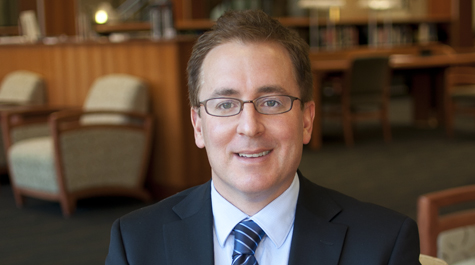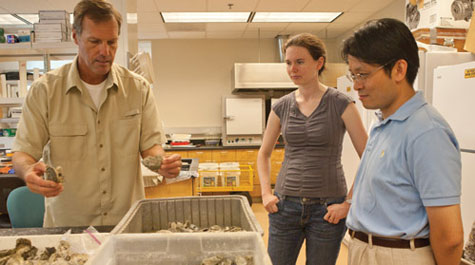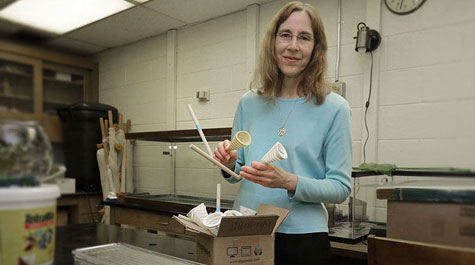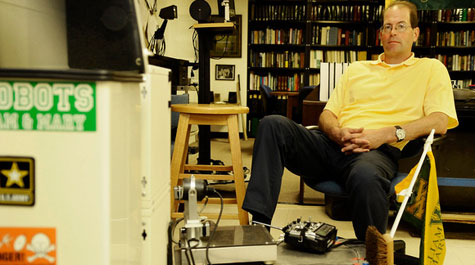W&M faculty in the media this month
Following are selected examples of William & Mary faculty and staff members in the media. - Ed.
Acoustic scarecrows: A humane, non-lethal way to reduce bird strikes?
In an April 18 Forbes article, Mark Hinders, professor of applied science at William & Mary, discussed the way acoustic “scarecrows” will help prevent midflight accidents for aircraft.
According to the article, an estimate of nearly $1 billion in damages to both civilian and military aircraft is due to bird strikes. In addition, the strikes have caused the deaths of 250 people since the late 90s.
Since this is such a serious matter, airport operations managers have tried to use a variety of approaches. These methods include pyrotechnics, firearms and falconry. But authorities have found that these techniques do not work for very long.
“You set out propane cannons, they’ll habituate. You broadcast predator calls, they’ll learn to ignore them,” said Hinders. “About the only things that work to exclude birds are nets, guns and poison but those are expensive and/or bad manners.”
This puzzle inspired Hinders and John Swaddle a professor of biology at W&M to develop an effective non-lethal deterrent.
Since birds are sensitive to some noises and particular sound frequencies, Hinders and Swaddle designed a “Sonic Net” to disrupt bird “conversations.”
With the use of “colored noise” they found that birds are annoyed by it and disperse.
“It’s like the cocktail party problem,” said Hinders. “You’re in a room and a lot of people are talking and it can be difficult to follow an individual conversation. It doesn’t even have to be especially loud. It’s just that all those other people’s words fill in the empty spaces. And so you go to a quiet room so that you can hear.”
Fish mouth inspires William & Mary biologist to design clog-resistant filter
In an April 16 Associated Press article, Laurie Sanderson, professor of biology at the William & Mary, discussed a way to create a clog-resistant filter.
According to the article, Sanderson looked at aquatic life such as the paddle fish and basking shark to see how and why they managed to filter particles so efficiently.
"When we looked inside the mouth, what we thought we would see is spaghetti caught on a strainer," said Sanderson. "But what we found in the species studied was particles dashed along at high speed toward the back of the throat toward the esophagus, and they didn't get stuck. They very rarely interacted with all those complex beautiful structures inside the fish mouth — the particles tended to go straight toward the back of the mouth."
Using what they noticed in fish, Sanderson and her students improved a commonly-used process called cross-flow filtration which clogs up very easily.
"We are able to stop the structure from clogging immediately with all the particulates that are entering the mouth," Sanderson said. "And we're able to concentrate particles in specific regions of the mouth that a standard filter is unable to do."
Clawing back
In an April 15 Daily Press article, Rom Lipcius, professor of marine sciences at William & Mary’s Virginia Institute of Marine Science (VIMS), talked about the resurgence of the Chesapeake blue crab.
According to the article, the blue crab population has been recovering over the past two years due to fishing regulations set by the Virginia Marine Resources Commission (VMRC).
The result of the annual bay-wide winter dredge survey stated that the crab population has improved 35 percent from last year.
Because crab numbers can fluctuate naturally for numerous reasons including habitat changes, storms and the populations of the aquatic species that prey on them, two years do not make a trend so the numbers are looked at with caution.
This news hasn’t deterred the optimism of Lipcius. He believes the regulations and management methods set forth by VRMC have been successful and that improvement in the blue crab population will continue to increase years to come.
“The management measures put in place in 2008 triggered the recovery of the population since 2009,” Lipcius said, “and provided resilience in the population to recover from natural disturbances.”
Bible wouldn't stay Tennessee's state book for long, some experts say
In an April 6 article in U.S. News & World Report, W&M Mills E. Goodwin, Jr. Professor of Law Timothy Zick spoke about a bill in Tennessee that would make the Holy Bible its official state book.
According to U.S. News, the state legislature gave the bill final approval in early April. However, Tennessee Attorney General Herbert Slatery stated that the proposal was against the First Amendment’s Establishment Clause and the state’s constitution.
Legal experts from around the country including William & Mary were in agreement with Slatery’s opinion.
“Singling out the Holy Bible for special recognition raises serious Establishment Clause and state constitutional concerns,” said Zick. “The adoption of the Holy Bible would signal the state’s official approval of the good book – in the same way that adopting the Latin cross as the state’s official symbol would endorse religion.”
 Skip to main content
Skip to main content




